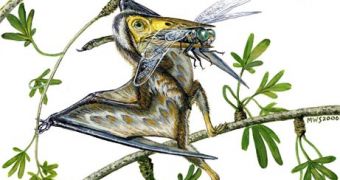Besides birds and bats, the only true flying vertebrates ever were a group of reptiles contemporaneous to dinosaurs, called pterosaurs. They were the first flying vertebrates (appeared 215 million years ago) that had wings make of skin similar to those of bats, but sustained only by one finger. Pterosaurs had the body covered by hair. In time, they evolved in many shapes and sizes, but they were gone at the same time with the dinosaurs, 65 million years ago. The largest pterosaur, Quetzalcoatlus, that lived about 85 million years ago in South America, is the largest flying animal known so far: it had a wingspan of 40 ft (12 m).
A new species of tiny pterosaur, described in the "Proceedings of the National Academy of Sciences," could explain the evolution from tiny to massive pterosaurs.
Nemicolopterus crypticus had a wingspan of just 10 in (25 cm) (smaller than a thrush) and lived 120 million years ago in Ginkgo forests, in northeastern China. The Chinese-Brazilian team discovered the N. crypticus fossil preserved in the fine siltstone. The minute pterosaur was toothless and had curved foot bones like in modern birds.
This is "one of the smallest pterosaurs known," co-founder Alexander Kellner, an adjunct professor at the Universidade Federal do Rio de Janeiro in Brazil, told National Geographic News.
"The feet indicate that the animal was adapted to living in trees. It likely darted across the dinosaur-dominated forests and lakes of the early Cretaceous period while feasting on insects," said Kellner.
The new species may point to the fact that the powered flight of the pterosaurs started with the between-trees glides of tiny pterosaurs, like N.crypticus.
"The discovery of the new fossil adds to evidence that the massive pterosaurs of the late Cretaceous evolved from smaller tree-living ancestors. The most primitive pterosaurs were small arboreal animals," said Thomas Holtz, a paleontologist at the University of Maryland.
N.crypticus "opens a new chapter on the evolutionary history of this group of volant [flying] reptiles. Asia certainly played a major role in the origin of [later] pterosaurs," added Kellner.

 14 DAY TRIAL //
14 DAY TRIAL //